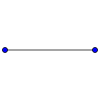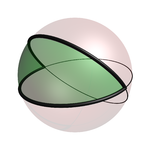Digon

In geometry a digon is a degenerate polygon with two sides (edges) and two vertices.
A digon must be regular because its two edges are the same length. It has Schläfli symbol {2}.
In spherical tilings

In Euclidean geometry a digon is always degenerate. However in spherical geometry a nondegenerate digon (with a nonzero interior area) can exist if the vertices are antipodal. The internal angle of the spherical digon vertex can be any angle between 0 and 180 degrees. Such a spherical polygon can also be called a lune.
In polyhedra
A digon is considered degenerate face of a polyhedron because it has no geometric area and overlapping edges, but it can sometimes have a useful topological existence in transforming polyhedra.
Any polyhedron can be topologically modified by replacing an edge with a digon. Such an operation adds one edge and one face to the polyhedron, although the result is geometrically identical. This transformation has no effect on the Euler characteristic (χ=V-E+F).
A digon face can also be created by geometrically collapsing a quadrilateral face by moving pairs of vertices to coincide in space. This digon can then be replaced by a single edge. It loses one face, two vertices, and three edges, again leaving the Euler characteristic unchanged.
Classes of polyhedra can be derived as degenerate forms of a primary polyhedron, with faces sometimes being degenerated into coinciding vertices. For example, this class of 7 uniform polyhedron with octahedral symmetry exist as degenerate forms of the the great rhombicuboctahedron (4.6.8). This principle is used in the Wythoff construction.
 4.4.4 |
 3.8.8 |
 3.4.3.4 |
 4.6.6 |
 3.3.3.3 |
 3.4.4.4 |
 4.6.8 |
See also
- Dihedron - a degenerate polyhedron with 2 faces.
- Hosohedron - a degenerate polyhedron with 2 vertices.
References
- Weisstein, Eric W. "Digon". MathWorld.
- A.B. Ivanov (2001) [1994], "Digon", Encyclopedia of Mathematics, EMS Press
{{citation}}: Unknown parameter|urlname=ignored (help)
